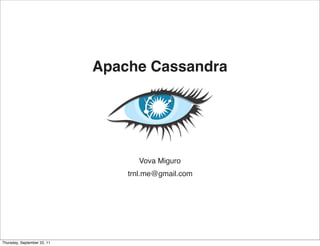
cassandra
- 1. Apache Cassandra Vova Miguro THE END trnl.me@gmail.com Thursday, September 22, 11
- 2. What is Cassandra? • key-value store with some structure • fault-tolerant • scalable • eventual consistent • tunable - consistency level - replication Thursday, September 22, 11
- 3. Where did it come from? • created at Facebook - Dynamo: distribution architecture - BigTable: data model • open-sourced in 2008 • Apache incubator in early 2009 • graduation in March 2010 Thursday, September 22, 11
- 4. Who uses it? • Facebook (of cource) • Rackspace • Twitter • Digg • Reddit • IBM • others... Thursday, September 22, 11
- 5. What problems does it solve? • reliability at scale - no single point of failure (all nodes are identical) • simple scaling (linear) • high write throughput • large data sets Thursday, September 22, 11
- 6. What problems it can’t solve? • no flexible indices (later about this) • not good for big binary data (>64mb) unless you chunk • row contents must fit in available memory Thursday, September 22, 11
- 7. Clustering: CAP • CAP Theorem - Consistency - Availability - Partition tolerance • choose two • Cassandra chooses A and P but allows them to be tunable to have more C Thursday, September 22, 11
- 8. Clustering: Replication & Consistency • replication factor - how many nodes data is replicated on • consistency level - zero (async write) - any - one - quorum (rf/2+1) - all Thursday, September 22, 11
- 9. Clustering: Consistency Level zero none write (async write) any 1st response write (included hinted handoff) one 1st response read/write quorum rf/2 + 1 read/write all all read/write Thursday, September 22, 11
- 10. Clustering: Ring • every node gets a token - defines its place in the ring - and which keys it is responsible for (ranges) Thursday, September 22, 11
- 11. Clustering:Ring • every node gets a token - defines its place in the ring - and which keys it is responsible for (ranges) Thursday, September 22, 11
- 12. Clustering:Ring • new node - token assignment - ranges adjusted - bootstrap - only neighbor nodes affected Thursday, September 22, 11
- 13. Clustering:Ring • node dies or becomes isolated • hinting handoff Thursday, September 22, 11
- 14. Data Model • keyspace • column family • row (indexed) • key • columns • name (sorted) • value Thursday, September 22, 11
- 15. Data Model: ColumnFamily families Column Thursday, September 22, 11
- 16. Supercolumn families Data Model: SuperColumnFamily Thursday, September 22, 11
- 17. Easier to start from the bottom up Thursday, September 22, 11
- 18. Data Model: Column Thursday, September 22, 11
- 19. Data Model: Row Thursday, September 22, 11
- 20. Data Model: Column comparators • TimeUUID • LexicalUUID • UTF8 • Long • Bytes • ... Thursday, September 22, 11
- 21. Data Model: ColumnFamily Thursday, September 22, 11
- 22. Writing • simple: put(key,col,value) • complex: put(key,[col,value,...col,value]) • batch: multi key Thursday, September 22, 11
- 23. Writes Writing Thursday, September 22, 11
- 24. Reading • get(): retrieve column by name • multiget(): by column name for a number of keys • get_slice(): by column name or a range of names - returning columns - returning supercolumns • multiget_slice(): a subset of columns for a set of keys • get_count(): number of columns or subcolumns • get_range_slice(): subset of columns for a range of keys Thursday, September 22, 11
- 25. Reads Reading Thursday, September 22, 11
- 26. Clients Python: •Pycassa: http://github.com/pycassa/pycassa •Telephus: http://github.com/driftx/Telephus (Twisted) • Java: •Hector: http://github.com/rantav/hector •Kundera http://github.com/impetus-opensource/Kundera •Pelops: http://github.com/s7/scale7-pelops •Cassandrelle (Demoiselle Cassandra): http://demoiselle.sf.net/ component/demoiselle-cassandra/ • .NET •Aquiles: http://aquiles.codeplex.com/ • Ruby: •Cassandra: http://github.com/fauna/cassandra • PHP: •PHP Client Library: https://github.com/kallaspriit/Cassandra-PHP- Client-Library •phpcassa: http://github.com/thobbs/phpcassa Thursday, September 22, 11
- 27. CQL (from 0.8) • USE • SELECT • INSERT/UPDATE • DELETE • TRUNCATE/DROP • BATCH • CREATE KEYSPACE • CREATE COLUMNFAMILY • CREATE INDEX Thursday, September 22, 11
- 28. CQL: Example CREATE COLUMNFAMILY users ( ... KEY varchar PRIMARY KEY, ... password varchar, ... gender varchar, ... session_token varchar, ... state varchar, ... birth_year bigint); INSERT INTO users (KEY, password) VALUES ('jsmith', 'ch@ngem3a'); SELECT * FROM users WHERE KEY='jsmith'; u'jsmith' | u'password',u'ch@ngem3a' DROP COLUMNFAMILY users; Thursday, September 22, 11
- 29. CQL: Example CREATE INDEX birth_year_key ON users (birth_year); CREATE INDEX state_key ON users (state); SELECT * FROM users ... WHERE gender='f' AND ... state='TX' AND ... birth_year='1968'; u'user1' | u'birth_year',1968 | u'gender',u'f' | u'password',u'ch@ngem3' | u'state',u'TX' DROP COLUMNFAMILY users; Thursday, September 22, 11
- 30. Indexing • secondary indexes - hashed - equality predicates (where column x = y) - specified on creation or later - best when many rows with similar columns • self-managed indexes Thursday, September 22, 11
- 31. Indexing: Self-managed: one-to-one indexed indexed value #1 value #2 index name related related key key Thursday, September 22, 11
- 32. Indexing: Self-managed: one-to-several indexed indexed value #1 value #2 index name related related related related key key key key Thursday, September 22, 11
- 33. Indexing: Self-managed: one-to-many related key related key indexed value #1 - - related key related key indexed value #2 - - Thursday, September 22, 11
- 34. Indexing: Self-managed: one-to-many ordering ordering indexed value value value #1 related key related key ordering ordering indexed value value value #2 related key related key Thursday, September 22, 11
- 35. Let’s practice: Twitter Get a user record by username • Get the friends of a username • Get the followers of a username • Get a timeline for a user • Get a timeline of a specific user’s tweets • Get a tweet from a tweet ID • Create a tweet • Create a user • Add friends to a user • Remove friends from a user Thursday, September 22, 11
- 36. Facebook messaging Thursday, September 22, 11
- 37. ? Thursday, September 22, 11
